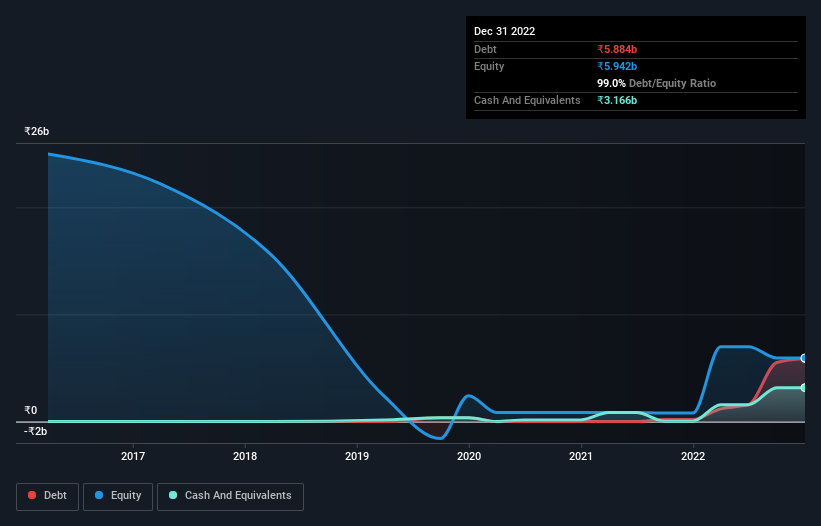- India
- /
- General Merchandise and Department Stores
- /
- NSEI:RTNINDIA
Does RattanIndia Enterprises (NSE:RTNINDIA) Have A Healthy Balance Sheet?

Howard Marks put it nicely when he said that, rather than worrying about share price volatility, 'The possibility of permanent loss is the risk I worry about... and every practical investor I know worries about.' So it might be obvious that you need to consider debt, when you think about how risky any given stock is, because too much debt can sink a company. We can see that RattanIndia Enterprises Limited (NSE:RTNINDIA) does use debt in its business. But is this debt a concern to shareholders?
When Is Debt Dangerous?
Generally speaking, debt only becomes a real problem when a company can't easily pay it off, either by raising capital or with its own cash flow. Part and parcel of capitalism is the process of 'creative destruction' where failed businesses are mercilessly liquidated by their bankers. However, a more common (but still painful) scenario is that it has to raise new equity capital at a low price, thus permanently diluting shareholders. Of course, plenty of companies use debt to fund growth, without any negative consequences. When we examine debt levels, we first consider both cash and debt levels, together.
View our latest analysis for RattanIndia Enterprises
What Is RattanIndia Enterprises's Net Debt?
You can click the graphic below for the historical numbers, but it shows that as of September 2022 RattanIndia Enterprises had ₹5.88b of debt, an increase on ₹200.0m, over one year. On the flip side, it has ₹3.17b in cash leading to net debt of about ₹2.72b.

How Healthy Is RattanIndia Enterprises' Balance Sheet?
We can see from the most recent balance sheet that RattanIndia Enterprises had liabilities of ₹18.8b falling due within a year, and liabilities of ₹345.8m due beyond that. Offsetting these obligations, it had cash of ₹3.17b as well as receivables valued at ₹830.6m due within 12 months. So its liabilities outweigh the sum of its cash and (near-term) receivables by ₹15.1b.
This deficit isn't so bad because RattanIndia Enterprises is worth ₹45.5b, and thus could probably raise enough capital to shore up its balance sheet, if the need arose. But it's clear that we should definitely closely examine whether it can manage its debt without dilution.
We measure a company's debt load relative to its earnings power by looking at its net debt divided by its earnings before interest, tax, depreciation, and amortization (EBITDA) and by calculating how easily its earnings before interest and tax (EBIT) cover its interest expense (interest cover). This way, we consider both the absolute quantum of the debt, as well as the interest rates paid on it.
Weak interest cover of 1.0 times and a disturbingly high net debt to EBITDA ratio of 9.0 hit our confidence in RattanIndia Enterprises like a one-two punch to the gut. The debt burden here is substantial. One redeeming factor for RattanIndia Enterprises is that it turned last year's EBIT loss into a gain of ₹302m, over the last twelve months. The balance sheet is clearly the area to focus on when you are analysing debt. But it is RattanIndia Enterprises's earnings that will influence how the balance sheet holds up in the future. So if you're keen to discover more about its earnings, it might be worth checking out this graph of its long term earnings trend.
Finally, a company can only pay off debt with cold hard cash, not accounting profits. So it is important to check how much of its earnings before interest and tax (EBIT) converts to actual free cash flow. During the last year, RattanIndia Enterprises burned a lot of cash. While investors are no doubt expecting a reversal of that situation in due course, it clearly does mean its use of debt is more risky.
Our View
To be frank both RattanIndia Enterprises's interest cover and its track record of converting EBIT to free cash flow make us rather uncomfortable with its debt levels. Having said that, its ability to grow its EBIT isn't such a worry. Overall, it seems to us that RattanIndia Enterprises's balance sheet is really quite a risk to the business. For this reason we're pretty cautious about the stock, and we think shareholders should keep a close eye on its liquidity. When analysing debt levels, the balance sheet is the obvious place to start. However, not all investment risk resides within the balance sheet - far from it. For example, we've discovered 2 warning signs for RattanIndia Enterprises (1 makes us a bit uncomfortable!) that you should be aware of before investing here.
If you're interested in investing in businesses that can grow profits without the burden of debt, then check out this free list of growing businesses that have net cash on the balance sheet.
New: AI Stock Screener & Alerts
Our new AI Stock Screener scans the market every day to uncover opportunities.
• Dividend Powerhouses (3%+ Yield)
• Undervalued Small Caps with Insider Buying
• High growth Tech and AI Companies
Or build your own from over 50 metrics.
Have feedback on this article? Concerned about the content? Get in touch with us directly. Alternatively, email editorial-team (at) simplywallst.com.
This article by Simply Wall St is general in nature. We provide commentary based on historical data and analyst forecasts only using an unbiased methodology and our articles are not intended to be financial advice. It does not constitute a recommendation to buy or sell any stock, and does not take account of your objectives, or your financial situation. We aim to bring you long-term focused analysis driven by fundamental data. Note that our analysis may not factor in the latest price-sensitive company announcements or qualitative material. Simply Wall St has no position in any stocks mentioned.
About NSEI:RTNINDIA
RattanIndia Enterprises
Engages in the manpower, human resource supply and consultancy, payroll management, technology, and other related services in India.
Slightly overvalued with questionable track record.
Market Insights
Community Narratives




